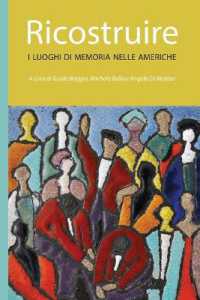基本説明
The articles in this volume are a selection from papers presented as part of a special section of the 2003 International Conference on Historical Linguistics (Copenhagen). The section centered around the plenary papers by Henning Andersen and William Croft, who presented competing views on the viability of an evolutionary model to explain language change. The other papers also included this volume represent additional theoretical models of change and their application.
Full Description
The articles of this volume are centered around two competing views on language change originally presented at the 2003 International Conference on Historical Linguistics in the two important plenary papers by Henning Andersen and William Croft. The latter proposes an evolutionary model of language change within a domain-neutral model of a 'generalized analysis of selection', whereas Henning Andersen takes it that cultural phenomena could not possibly be handled, i.e. observed, described, understood, in the same way as natural phenomena. These papers are models of succinct presentation of important theoretical framework. The other papers present and discuss additional models of change, e.g. invisible hand-processes, system-internal models, functional and cognitive models. Most papers do not subscribe to the evolutionary model; instead, they focus on functional factors in the selection and propagation of variants (as opposed to factors of code efficiency), or on cognitive and pragmatic perspectives. Several papers are inspired by the late Eugenio Coseriu and by Henning Andersen's theories on language change. In particular, the volume contains articles proposing interesting grammaticalization studies and extended models of grammaticalization. The clear presentation of important and competing approaches to fundamental questions concerning language change will be of high interest for scholars and students working in the field of diachrony and typology. The languages referred to in the papers include Cantonese, the Chukotko-Kamchatkan languages, Danish, English, Eskimo languages, German, Norwegian, Russian, Spanish, and Swedish.
Contents
1. Introduction (by Nedergaard Thomsen, Ole); 2. I: General considerations of language change; 3. The non-linear nature of diachronic change (by Fortescue, Michael); 4. Explanations, or...?: Some metatheoretical reflections on a prevalent tradition within historical linguistics (by Maehlum, Brit); 5. Quantifying the functional load of phonemic oppositions, distinctive features, and suprasegmentals (by Surendran, Dinoj); 6. II: The concept of 'evolution' as an explanatory model of language change: Pro et contra synchrony, diachrony, and evolution; 7. Synchrony, Diachrony, and Evolution (by Andersen, Henning); 8. The relevance of an evolutionary model to historical linguistics (by Croft, William A.); 9. III: Functional factors in 'evolution': Functional motivation of selection; 10. Grammaticalization of indirect object cross-reference in Spanish as a case of drift (by Bascunan, Silvia Becerra); 11. The role of functional factors in language change: An evolutionary approach (by Seiler, Guido); 12. Computational modelling of prototypicality in language change: Neutralization to schwa, default logic, and the history of the German noun (by Vazquez-Larruscain, Miguel); 13. IV: Cognitive perspectives on semantico-syntactic change: Mental Grammar, Cognitive Grammar, and Dynamic Syntax; 14. From propositional syntax in Old Russian to situational syntax in Modern Russian (by Durst-Andersen, Per); 15. Construal operations in semantic change: The case of abstract nouns (by Ekberg, Lena); 16. Clitic Placement in Old and Modern Spanish: A Dynamic Account (by Bouzouita, Miriam); 17. V: Grammaticalization studies: Content and evolution; 18. Grammaticalisation as content reanalysis: The modal character of the Danish s-passive (by Heltoft, Lars); 19. Aspect and animacy in the history of Russian: Developing the idea of parallel grammaticalization (by Norgard-Sorensen, Jens); 20. VI: Towards an integrated functional-pragmatic theory of language and language change; 21. Towards an integrated functional-pragmatic theory of language and language change: In commemoration of Eugenio Coseriu (1921-2002) (by Nedergaard Thomsen, Ole); 22. Index; 23. Contributors







